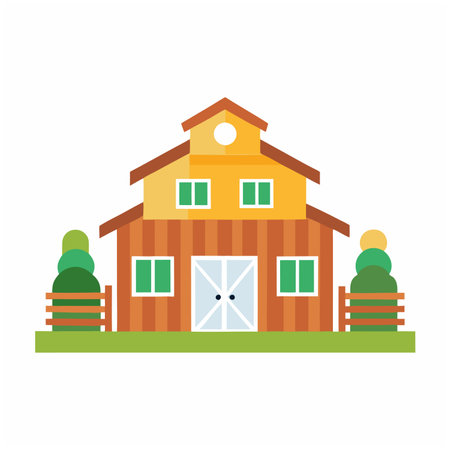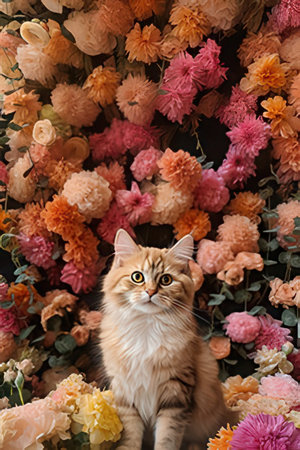1. Understanding Pet-Friendly Gardening
If you’re a pet owner in America, planning your garden isn’t just about beautiful flowers or a fresh vegetable patch—it’s about keeping your furry friends safe and happy, too. Pets, especially dogs and cats, are naturally curious and love to explore outdoor spaces. This curiosity can put them at risk if your garden includes toxic plants, unsafe materials, or hidden hazards. Let’s break down why considering pets is essential in your garden planning process.
Why Your Pets Matter in Garden Design
For many American households, pets are family. According to the American Pet Products Association, nearly 70% of U.S. households own a pet. Dogs and cats spend significant time outdoors—playing, digging, or lounging in the grass. A pet-friendly garden means creating an environment that encourages exploration but also prioritizes safety.
Common Risks for Pets in Gardens
| Risk Type | Description | Examples |
|---|---|---|
| Toxic Plants | Certain common garden plants can be poisonous if chewed or ingested by pets. | Lilies (cats), Azaleas (dogs/cats), Sago Palm |
| Pesticides & Fertilizers | Chemical treatments used on lawns and gardens can cause illness if licked off paws or fur. | Slug bait, Weed killers, Synthetic fertilizers |
| Sharp Objects & Mulch | Thorns, sticks, or certain types of mulch can injure pets’ paws or cause digestive issues if swallowed. | Cocoa mulch (toxic), Rose thorns |
How Pets Interact with Outdoor Spaces
Pets use gardens as their personal playgrounds. Dogs might dig up flower beds, sniff around bushes, or chase squirrels; cats may nap under shady plants or climb small trees. When designing your garden, it’s important to think like your pet—consider what attracts their attention and where they might get into trouble.
Quick Tips for Observing Your Pet’s Behavior Outdoors
- Notice favorite digging spots or resting areas.
- Watch which plants your pet sniffs or tries to nibble.
- Check for places where your pet squeezes through fences or gets stuck.
By understanding how pets interact with outdoor spaces and what risks exist, you can lay the groundwork for a safe and enjoyable garden for everyone in your household—including those with paws!
2. Identifying Toxic and Safe Plants for Pets
Why Plant Safety Matters for Pet Owners
If you’re planning a garden with your pets in mind, choosing the right plants is more than just about curb appeal—it’s about keeping your furry friends safe. Dogs and cats are naturally curious, and they often nibble on leaves or dig around in garden beds. Some common garden plants can be toxic if ingested, leading to anything from mild stomach upset to serious health emergencies. Knowing which plants are pet-friendly and which ones to avoid can make all the difference.
Safe Garden Plants for Dogs and Cats
Good news: there are plenty of beautiful, American-favorite plants that are non-toxic to both dogs and cats. Here’s a quick guide to some popular options you can confidently add to your backyard oasis:
| Plant Name | Type | Why It’s Great |
|---|---|---|
| Sunflower (Helianthus annuus) | Flower | Bright, cheery, and totally safe for pets |
| Basil (Ocimum basilicum) | Herb | Easy to grow; perfect for kitchen gardens and pet-safe |
| Rosemary (Rosmarinus officinalis) | Herb/Shrub | Aromatic and pet-friendly; great for grilling too! |
| Zinnia (Zinnia elegans) | Flower | Adds color without risk to pets |
| Cilantro (Coriandrum sativum) | Herb | Tasty for humans, harmless for pets |
| Peppermint (Mentha piperita) | Herb/Groundcover | Lively scent, safe for most pets (in small amounts) |
| Crape Myrtle (Lagerstroemia indica) | Shrub/Tree | A Southern favorite that’s pet-safe too! |
| Camelia (Camellia japonica) | Shrub/Flowering Bush | Blooms beautifully, non-toxic for cats and dogs |
Toxic Plants Commonly Found in American Gardens (According to ASPCA)
The following plants may look lovely but can be dangerous if your dog or cat decides to chew on them. Based on ASPCA guidelines, steer clear of these in any pet-friendly landscape:
| Plant Name | Main Risk(s) | Common Symptoms in Pets |
|---|---|---|
| Lily (Lilium spp.) | Toxic to cats (especially) | Kidney failure, vomiting, lethargy |
| Sago Palm (Cycas revoluta) | Toxic to dogs and cats | Liver damage, vomiting, seizures |
| Aloe Vera (Aloe barbadensis miller) | Toxic to dogs and cats | Vomiting, diarrhea, tremors |
| Daffodil (Narcissus spp.) | Toxic bulbs | Nausea, vomiting, heart issues |
| Azalea/Rhododendron (Rhododendron spp.) | Toxic to dogs and cats | Drooling, vomiting, coma |
| Ivy (Hedera helix/English Ivy) | Toxic to dogs and cats | Abdominal pain, drooling, diarrhea |
| Tulip (Tulipa spp.) | Toxic bulbs | Mouth irritation, drooling, nausea |
Pep Talk: Plan Smart—Your Pets Will Thank You!
Selecting the right plants doesn’t have to be complicated. Stick with tried-and-true pet-safe picks, double-check new additions against the ASPCA’s plant database, and you’ll enjoy a vibrant garden where everyone—two-legged or four—can relax safely.

3. Garden Layout Strategies for Pet Safety
Fencing: Your First Line of Defense
One of the easiest ways to keep your furry friends safe is with a sturdy fence. Choose a fence that is tall enough for dogs who love to jump and has no gaps where smaller pets can squeeze through. For cats, consider cat-proof fencing or add a roll bar on top to prevent climbing escapes.
| Fence Type | Best For | Key Features |
|---|---|---|
| Wooden Fence | Dogs (all sizes) | Solid barrier, privacy, customizable height |
| Wire Mesh Fence | Cats & Small Dogs | No gaps, add mesh overhang for climbers |
| Picket Fence | Small/Medium Dogs | Classic look, check spacing between pickets |
Designated Pet Zones: Give Them Their Own Space
Create a special area just for your pet—think of it as their backyard playground. Use mulch or pet-friendly turf for digging and playing. Add shade with a doghouse or canopy so they can relax comfortably outside.
Pet Zone Ideas:
- Digging pit: Fill a sandbox with clean sand for dogs who love to dig.
- Shaded rest spot: Place a dog bed under a tree or use an outdoor tent.
- Toy storage: Keep outdoor toys in a waterproof box nearby.
Raised Beds: Protect Your Plants (and Your Pets)
Raised garden beds are great for keeping curious noses out of your veggies and flowers. They also make it easier to control what goes into your soil, reducing the risk of pets ingesting harmful fertilizers or pesticides.
- Height matters: Aim for at least 18-24 inches tall to discourage most dogs from jumping in.
- Add barriers: Install low wire hoops or mesh covers if you have persistent diggers or cats that like to climb.
- Select materials carefully: Use untreated wood or recycled plastic that won’t leach chemicals into the soil.
Pet Access Paths: Direct Traffic the Smart Way
Create clear pathways for your pets using stepping stones, pea gravel, or mulch. These paths give your pets a route to explore without trampling sensitive plants. Plus, they help keep muddy paws off your patio!
- Smooth surfaces: Choose materials that are gentle on paws—avoid sharp rocks or hot concrete.
- Easy access: Make sure paths lead to favorite hangouts like shady spots, water bowls, and play zones.
- Curb wandering: Line paths with low borders or shrubs to subtly guide pets away from off-limits areas.
4. Pet-Proofing Your Garden: Barriers and Deterrents
When you’re planning a garden with pets in mind, it’s important to create spaces that are not only safe but also off-limits where necessary. Dogs love to dig, cats might see your raised beds as a litter box, and curious pups will nibble on almost anything! The good news? You don’t have to fence off your whole yard. Instead, use smart pet-proofing strategies to keep your plants safe and your furry friends out of trouble.
Natural Deterrents That Really Work
Pepper flakes, citrus peels, and vinegar can help discourage pets from entering certain areas. Many animals dislike the smell of citrus or strong spices, so sprinkling orange or lemon peels around sensitive flower beds is a natural way to keep them away. Just remember to refresh these deterrents regularly, especially after rain.
Common Natural Deterrents
| Deterrent | How to Use | Pets It Deters |
|---|---|---|
| Citrus Peels | Scatter around garden edges or in problem spots | Cats & Dogs |
| Pepper Flakes | Sprinkle directly on soil (avoid windy days) | Cats & Dogs |
| Coffee Grounds | Mix into mulch or topsoil | Cats |
| Vinegar Spray | Lightly spray on stones or paths (not on plants) | Dogs |
The Right Mulch Can Make a Difference
Choosing the right mulch is key for both plant health and pet safety. Cocoa mulch smells great but is toxic to dogs—so skip it! Instead, go for pine bark, cedar chips, or straw. These are safe options that also discourage digging because they’re not as fun or soft for paws.
Mulch Types: Safe vs. Unsafe for Pets
| Safe Mulches | Avoid These Mulches |
|---|---|
| Pine Bark Cedar Chips Straw Rubber Mulch (for non-chewers) |
Cocoa Hulls Pebbles (can be swallowed) Dye-Treated Mulch |
Physical Barriers: Out of Sight, Out of Mind!
If you need a guaranteed way to keep pets away from delicate seedlings or vegetable beds, physical barriers work best. Low fences made of chicken wire, decorative garden borders, or even repurposed baby gates can block off special sections without ruining your yard’s look.
- Chicken Wire Fencing: Cheap and easy to install around raised beds.
- Decorative Edging: Short picket fences or stone borders add style while keeping pets at bay.
- Garden Netting: Lay flat over newly seeded patches to prevent digging.
- Bamboo Stakes: Place close together to make hopping in less appealing.
Troubleshooting Tips for Persistent Pets
- If your dog loves digging in one spot, try placing large flat stones there—they’ll move on quickly!
- Scented deterrents lose strength over time; reapply every few days or after watering/rain.
- If you use netting or small fencing, check regularly for gaps that could trap paws or noses.
With these pet-proofing tricks, you can enjoy a thriving garden without constantly worrying about your furry friends getting into mischief. Smart planning now saves headaches—and vet bills—later!
5. Fun and Enrichment: Garden Ideas for Happy Pets
Creating a pet-friendly garden isn’t just about safety—it’s also about making your outdoor space fun and enriching for your furry family members. A thoughtful garden design can transform your yard into a playground, chill zone, and sensory wonderland for dogs and cats alike. Here are some creative ideas to keep tails wagging and whiskers twitching!
Digging Spots for Dogs
If your pup loves to dig, why not give them a designated digging area? Fill a sandbox or corner of the yard with soft soil or play sand, and hide toys or treats to encourage them to use their “legal” spot instead of your flower beds. This not only satisfies their instincts but also protects the rest of your garden.
How to Set Up a Digging Zone
| Feature | What You Need | Benefits |
|---|---|---|
| Sandbox or Raised Bed | Wooden frame, sand/loose soil | Contains mess, easy to refill |
| Toys/Treats Hidden Inside | Bones, chew toys, safe treats | Keeps dogs engaged and happy |
| Shade Overhead | Umbrella or shade cloth | Makes digging comfortable on hot days |
Shady Rest Zones for All Pets
Pets need a cool place to relax after playing. Create cozy shaded areas using trees, pergolas, or even pop-up tents. Add pet beds, outdoor rugs, or waterproof cushions so your pets have a comfy spot to lounge.
Easy Shade Solutions
- Tall shrubs or fast-growing trees: Natural shade that blends in with your garden design.
- Outdoor umbrellas: Moveable and easy to set up wherever needed.
- Pergolas with climbing vines: Stylish and provides filtered sunlight.
- Pet teepees or tunnels: Fun hideouts that double as shade spots.
Patches of Pet-Safe Greens: Kitty Grass & More
Cats (and some dogs) love munching on grass! Plant patches of pet-safe greens like wheatgrass, oat grass, or catnip in containers or garden beds. This gives indoor/outdoor kitties something safe to nibble—and keeps them away from less safe plants.
Best Grasses & Herbs for Your Garden
| Plant Name | Best For | Why It’s Great |
|---|---|---|
| Wheatgrass (Triticum aestivum) | Cats & Dogs | Aids digestion, fun to chew on |
| Catnip (Nepeta cataria) | Cats | Energizes & entertains most felines |
| Lemongrass (Cymbopogon citratus) | Cats & Dogs (in moderation) | Pleasant scent, natural pest repellent |
| Basil (Ocimum basilicum) | Cats & Dogs | Mild flavor, non-toxic herb |
Sensory Paths and Exploration Trails
Add winding paths made of smooth stones or mulch that invite pets to explore safely. You can line these trails with edible herbs, low-growing pet-safe flowers, or even little tunnels for cats. The more variety you add—textures, scents, places to hide—the more enriched your pets’ outdoor experience will be.
Quick Tips for Maximum Pet Enjoyment
- Create different zones: Play, rest, eat, explore!
- Rotate toys and enrichments weekly to keep things interesting.
- Add water features like shallow fountains for drinking and splashing (make sure they’re safe and clean).
Your backyard can be both beautiful and a daily adventure zone when you plan with your pets in mind!
6. Maintaining a Healthy Outdoor Space for All
Keeping your garden both beautiful and safe for pets takes some thoughtful maintenance. The goal is to help your plants thrive while making sure your furry friends stay healthy and happy. Here’s how you can keep your outdoor space in tip-top shape with pet-safe choices all year long.
Pet-Safe Fertilizers: Feeding Your Garden Without Risks
Traditional fertilizers often contain chemicals that are harmful if licked or eaten by pets. Luckily, there are plenty of safer, eco-friendly options. Here’s a quick look at what works best:
| Fertilizer Type | Pet Safety Level | Notes |
|---|---|---|
| Compost (homemade or store-bought) | Safe | Avoid adding meat, dairy, or bones to compost to prevent attracting animals. |
| Seaweed-based fertilizer | Very Safe | Rich in nutrients, usually odorless, and non-toxic to pets. |
| Fish emulsion | Generally Safe | Mild smell may attract dogs; store securely. |
| Synthetic chemical fertilizer | Avoid | Pesticides and chemicals can be toxic to pets if ingested. |
Pest Control That Won’t Harm Your Pets
Bugs are part of any garden, but some control methods are dangerous for cats and dogs. Choose solutions that work without putting your pets at risk:
- Diatomaceous earth (food grade): This powder kills bugs but is harmless to pets—just make sure it’s labeled food-grade.
- Nematodes: These microscopic worms naturally control pests like grubs and fleas without harming other animals.
- Neem oil: A natural plant extract that keeps bugs away; dilute before spraying and keep pets off treated areas until dry.
- No-go list: Avoid slug pellets, rodenticides, and systemic pesticides—they’re all highly toxic to pets!
Lawn Care Tips for Pet Owners
Your grass can take a beating from playtime, digging, and bathroom breaks. Here are some smart ways to keep it green and safe:
- Mow high—longer grass is tougher and stands up better to pet traffic.
- Rinse areas where pets urinate with water to prevent brown spots.
- Avoid “weed and feed” products that combine fertilizer with herbicides—these mixtures can be toxic.
- If using mulch, skip cocoa mulch (it’s toxic to dogs) and choose cedar or pine bark instead.
Seasonal Maintenance Checklist for Pet-Friendly Gardens
| Season | Must-Do Tasks |
|---|---|
| Spring | Test soil; use compost; reseed bare patches; check for new weeds or pests; refresh mulch. |
| Summer | Irrigate deeply but less often; shade hot spots; monitor for ticks/fleas. |
| Fall | Aerate lawn; remove fallen leaves (they can hide mold); plant hardy perennials. |
| Winter | Avoid salt-based deicers on paths—use pet-safe alternatives like sand or kitty litter instead. |
Your Garden Is a Shared Sanctuary—Keep It Thriving Safely!
The right maintenance habits protect your plants, your investment in landscaping, and—most importantly—your four-legged family members. With a little planning, you’ll have a lush garden that’s as safe as it is stunning all year round.

